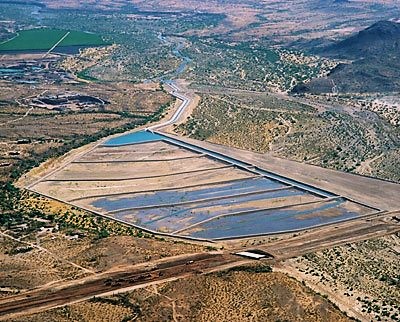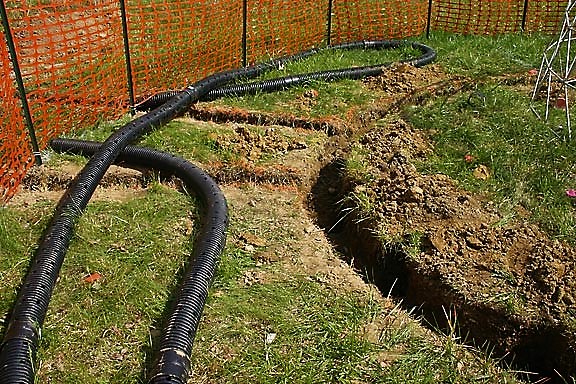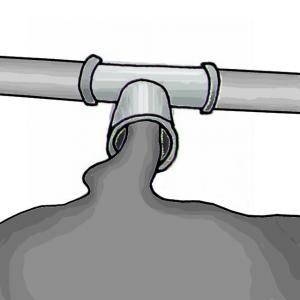Resumen ejecutivo
Treated effluent and/or stormwater can be directly discharged into receiving water bodies (such as rivers, lakes, etc.) or into the ground to recharge aquifers. This is particularly useful in areas where water and groundwater resources are heavily utilised or water scarcity in general exists. Artificial aquifer or groundwater recharge is the planned, man-made increase of groundwater levels by improving replenishment capacities and percolation from waters into aquifers. Typical methods are surface groundwater recharge and subsurface groundwater recharge. Surface groundwater recharge refers to released effluents and water from the surface into the groundwater aquifer via soil percolation. Subsurface groundwater recharge refers to injection or recharge wells that release treated effluent and/or collected stormwater underground and directly replenish groundwater aquifers.
| Entradas | Salidas |
|---|---|
Precipitation, Freshwater, Fertigation Water, Treated Water, |
- |
Surface Disposal
If there is no other more productive reuse intention the final effluents from sanitation systems that underwent a proper treatment (see also horizontal, vertical flow and free-surface flow constructed wetlands, waste stabilisation ponds, aerated ponds or rotating biological contactors) can be discharged directly into receiving water bodies such as creeks, rivers, lakes etc.
This allows recharging these surface water bodies, linked groundwater resources (see also surface groundwater recharge and sub-surface groundwater recharge) and thus contributes to the overall integrated management of the water resources (see also the water cycle and IWRM).
The use of the surface water body, whether it is for industry, recreation, spawning habitat, etc., will influence the quality and quantity of treated wastewater that can be introduced without deleterious effects.
Groundwater Recharge
Alternatively, water can be discharged into aquifers. Artificial groundwater recharge is the planned infiltration of effluents from sanitation systems (e.g. wastewater stabilisation ponds, surface, horizontal flow or vertical flow constructed wetlands), stormwater or surface runoff into the aquifer in order to increase the natural replenishment of groundwater resources. Artificial surface and subsurface groundwater recharge refer to different groundwater recharge techniques that release effluent from above or below the ground into the groundwater via soil percolation. Artificial recharge can be of two types, mainly surface ground water recharge or subsurface ground water recharge. Groundwater recharge is increasing in popularity as groundwater resources deplete and as saltwater intrusion becomes a greater threat to coastal communities. It is also useful in areas where soil salinisation or water scarcity in general exist. Artificial recharge has also been used for many other beneficial purposes. These include additional treatment (through soil filtration, see also soil aquifer treament) and conservation or disposal of treated wastewater or floodwaters, crop development, stream flow augmentation, as well as storage of water to reduce pumping and piping costs as well as temporary regulation of groundwater abstraction (ASANO 1985, OAKSFORD 1985, UNEP 1998). Soil aquifer treatment can moreover increase water quality through the removal of suspended solids via soil filtration or through the dilution with naturally occurring groundwater (ASANO 1985). Although the soil is known to act as a filter for a variety of contaminants, groundwater recharge should not be viewed as a stand-alone treatment method. Once an aquifer is contaminated, it is next to impossible to reclaim it.
Design Considerations

It is necessary to ensure that the assimilation capacity of the receiving water body is not exceeded, i.e. that the receiving surface or groundwater body can accept the quantity of nutrients without being overloaded (see also water pollution and pathogens and contaminants). To avoid chemical reactions that would reduce aquifer porosity and recharge capacity, the recharge water must also be chemically compatible with the naturally occurring groundwater and the aquifer material that it flows through. Parameters such as turbidity, temperature, suspended solids, BOD, nitrogen and phosphorus (among others) should be carefully controlled and monitored before releasing any water into a natural body. Local authorities should be consulted to determine the discharge limits for the relevant parameters as they can widely vary. For especially sensitive areas, a post-treatment technology (e.g., chlorination, see also post treatment methods) may be required to meet microbiological limits.

Polluted wastewater should be treated before surface/subsurface groundwater recharge. The quality of water extracted from a recharged aquifer is a function of the quality of the wastewater introduced, the method of recharge, the characteristics of the aquifer, the residence time, the amount of blending with other waters and the history of the system. Careful analysis of these factors should precede any recharge project. See also surface groundwater recharge and subsurface groundwater recharge to read more on typical methods how to recharge groundwater.
Health Aspects/Acceptance
Generally, cations (Mg2+, K+, NH4+) and organic matter will be retained within a solid matrix, while other contaminants (such as nitrates) will remain in the water. There are numerous models for the remediation potential of contaminants and microorganisms, but predicting downstream or extracted water quality for a large suite of parameters is rarely feasible. Therefore, potable and non-potable water sources should be clearly identified, the most important parameters modelled and a risk assessment completed.
Operation & Maintenance
Regular monitoring and sampling is important to ensure compliance with regulations and to ensure public health requirements (see also water pollution and pathogens and contaminants). Depending on the recharge method, some mechanical maintenance may be required. In order to guarantee smooth operation and prevent any risk of pollution of clean aquifer, a thorough and detailed hydro geological study should be conducted before selecting the site and the method od recharge. In particular, the following basic factors should be considered (UNEP 1998):
- Location of geologic and hydraulic boundaries
- Depth of the aquifer and transmissivity of the overlying material
- Lithology
- Storage capacity
- Porosity
- Hydraulic conductivity and natural in- and outflow of water to/from the aquifer
- Availability of land, surrounding land use and topography
- Economic and legal aspects concerning the recharge
- Degree of public acceptance
The adequacy of discharge into a water body or aquifer will entirely depend on the local environmental conditions (e.g. hydraulic conductivity, nutrient assimilation capacity of the receiving bodyor underground soil), quality and quantity of the water to be infiltrated, and legal regulations. Generally, discharge to a water body is only appropriate when there is a safe distance between the discharge point and the next closest point of use (see also water pollution and pathogens and contaminants). Similarly, groundwater recharge is most appropriate for areas that are at risk of saltwater intrusion , dropping water sheds or aquifers that have a long retention time. Depending on the volume, the point of discharge and/or the quality of the water, a permit may be required. The physical, chemical and biological quality of recharge water also affects the selection of the recharge method. If suspended solids are present, surface application techniques tend to be more efficient than sub-surface techniques that can result in clogging of injection wells. However, recharge waters containing toxic chemicals or chemicals that could reduce aquifer porosity or recharge capacity must also be pre-treated if used for artificial groundwater recharge. Cultural and socio-economic considerations, availability of land, or land uses in adjacent areas may also affect the selection of a recharge method and site. In urban areas, where land availability, costs and uses in adjacent areas may impose restrictions, injection wells, shafts or small pits requiring highly controlled water supplies and little land area may be preferable to larger scale, surface spreading recharge methods. Surface recharge facilities generally require protected property boundaries, regular maintenance and continuous surveillance if they are to be accepted by the public.
Guidelines for Assessing the Risk to Groundwater from On-Site Sanitation
Many people in developing countries rely upon untreated groundwater supplies for their drinking water (e.g. from drilled boreholes, tube wells, dug wells or springs). The introduction of on-site sanitation systems might lead to groundwater contamination. The purpose of this manual is to provide guidance on how to assess and reduce the risk of contamination of groundwater supplies from on-site sanitation systems and is aimed at those responsible for planning low cost water supply and sanitation schemes.
ARGOSS (2001): Guidelines for Assessing the Risk to Groundwater from On-Site Sanitation. (= Commissioned Report , 142 ). Keyworth: British Geological Survey URL [Visita: 11.05.2019]The Artificial Recharge of Groundwater
Drainage Ditches Flanking the Path into and out of Wholeo Dome
Typical spreading basin
Artificial Recharge: Methods, Hydraulics, and Monitoring
Groundwater Recharge from Run-off, Infiltration and Percolation
Wastewater Engineering, Treatment and Reuse
Compendium of Sanitation Systems and Technologies. 2nd Revised Edition
This compendium gives a systematic overview on different sanitation systems and technologies and describes a wide range of available low-cost sanitation technologies.
TILLEY, E., ULRICH L., LÜTHI, C., REYMOND P. and ZURBRÜGG C. (2014): Compendium of Sanitation Systems and Technologies. 2nd Revised Edition. Duebendorf, Switzerland: Swiss Federal Institute of Aquatic Science and Technology (Eawag) URL [Visita: 03.05.2023] PDFSourcebook of Alternative Technologies for Freshwater Augmentation in Some Countries in Asia (Technical Publication)
Guidelines for the safe use of wastewater excreta and greywater. Volume III. Wastewater and Excreta Use in Aquaculture
Volume III of the Guidelines for the Safe Use of Wastewater, Excreta and Greywater deals with wastewater and excreta use in aquaculture and describes the present state of knowledge regarding the impact of wastewater-fed aquaculture on the health of producers, product consumers and local communities. It assesses the associated health risks and provides an integrated preventive management framework.
WHO (2006): Guidelines for the safe use of wastewater excreta and greywater. Volume III. Wastewater and Excreta Use in Aquaculture. Geneva: World Health Organisation URL [Visita: 08.05.2019]Compendium of Sanitation Systems and Technologies (Arabic)
This is the Arabic version of the Compendium of Sanitation Systems and Technologies. The Compendium gives a systematic overview on different sanitation systems and technologies and describes a wide range of available low-cost sanitation technologies.
TILLEY, E. ULRICH, L. LUETHI, C. REYMOND, P. SCHERTENLEIB, R. ZURBRUEGG, C. (2014): Compendium of Sanitation Systems and Technologies (Arabic). 2nd Revised Edition. Duebendorf, Switzerland: Swiss Federal Institute of Aquatic Science and Technology (Eawag) PDFGroundwater recharge with recycled municipal wastewater: Criteria for health related guidelines
This article aims to highlight some principles related to aquifer recharge with recycled water, and to propose a simple approach to health related guidelines that take into account existing water regulations and guidelines.
BRISSAUD, F. (1999): Groundwater recharge with recycled municipal wastewater: Criteria for health related guidelines. France: Hydrosciences, MSE, Univ. Montpellier II, 34095 Montpellier Cedex 05Management of aquifer recharge and discharge processes and aquifer storage equilibrium
This paper draws attention to case studies from a range of hydro-geological, climatic and societal settings where innovative management has been successful in reversing groundwater storage declines (or increases). Informing and engaging stakeholders in governance has resulted in more resilient outcomes that take better account of local needs. Importantly, in many settings local action by motivated communities has run ahead of state and national policies and been highly effective in managing groundwater storage, increasing farm incomes and protecting the environment.
FAO GEF IAH IHP World Bank (2012): Management of aquifer recharge and discharge processes and aquifer storage equilibrium. Food and Agriculture Organization (FAO) URL [Visita: 08.04.2013]Artificial Recharge and Rainwater Harvesting
Innovations in Groundwater Recharge. Water Policy Briefing. IWMI-TATA Water Policy Program
This brochure gives an overview on different low-cost aquifer recharge solutions based on the results from a 10-year pilot project in Uttar Pradesh. It indicates a practical and low-cost way to conserve and rejuvenate falling groundwater reserves.
IWMI (2002): Innovations in Groundwater Recharge. Water Policy Briefing. IWMI-TATA Water Policy Program. Vallabh Vidyanagar: International Water Management Institute URL [Visita: 21.03.2019]Water Harvesting
Water harvesting has been practiced successfully for millennia in parts of the world – and some recent interventions have also had significant local impact. Yet water harvesting’s potential remains largely unknown, unacknowledged and unappreciated. These guidelines cover a wide span of technologies from large-scale floodwater spreading to practices that collect and store water from household compounds.
MEKDASCHI STUDER, R. LINIGER, H. (2013): Water Harvesting. Guidelines to Good Practice. Bern/Amsterdam/Wageningen/Rome: Centre for Development and Environment (CDE), Rainwater Harvesting Implementation Network (RAIN), MetaMeta, The International Fund for Agricultural Development (IFAD) URL [Visita: 12.03.2019] PDFGuide on Artificial Recharge to Groundwater
This document provides guidance on artificial recharge techniques and designs and the planning and monitoring of artificial recharge projects.
MINISTRY OF WATER RESOURCES (2000): Guide on Artificial Recharge to Groundwater. New Delhi: Central Ground Water Board URL [Visita: 21.03.2019]Chapter 9: Artificial Groundwater Recharge
This is a chapter on a rainwater-harvesting manual from the Public Health Engineering Department in India. It gives an extensive overview on different groundwater recharge technologies and approaches.
PHEDM (n.y): Chapter 9: Artificial Groundwater Recharge. Entradas: PHEDM (n.y): Rain Water Harvesting ManuaI. Meghalaya State Centre, India: . URL [Visita: 26.05.2019]Small Community Water Supplies: Technology, People and Partnership: Artificial Recharge - Chapter 6
This book provides a general introduction to a wide range of technologies. Among the topics covered are: planning and management of small water supplies, community water supplies in Central and Eastern European countries, water quality and quantity, integrated water resources management, artificial recharge, rainwater harvesting, spring water tapping, groundwater withdrawal, water lifting, surface water intake, water treatment, aeration, coagulation and flocculation, sedimentation, multi-stage filtration, desalination technology, disinfection, household level water treatment, technologies for arsenic and iron removal from ground water, and emergency and disaster water supply. Chapter 6: Artificial Recharge
SMET, J. ; WIJK, C. van (2002): Small Community Water Supplies: Technology, People and Partnership: Artificial Recharge - Chapter 6. The Hague: International Water and Sanitation Centre (IRC) URL [Visita: 21.03.2019]Compendium of Sanitation Systems and Technologies. 2nd Revised Edition
This compendium gives a systematic overview on different sanitation systems and technologies and describes a wide range of available low-cost sanitation technologies.
TILLEY, E., ULRICH L., LÜTHI, C., REYMOND P. and ZURBRÜGG C. (2014): Compendium of Sanitation Systems and Technologies. 2nd Revised Edition. Duebendorf, Switzerland: Swiss Federal Institute of Aquatic Science and Technology (Eawag) URL [Visita: 03.05.2023] PDFGroundwater recharge with recycled municipal wastewater: health and regulatory considerations
This case study on groundwater recharge with recycled wastewater focuses on quantifying possible health implications.
ASANO, T. COTRUVO, J. (2004): Groundwater recharge with recycled municipal wastewater: health and regulatory considerations. Davis: Department of Civil and Environmental Engineering, University of California URL [Visita: 15.04.2011]Water and Community Development. Rainwater harvesting and groundwater recharge. A sustainable approach to human development at the global level
Article on rainwater harvesting and groundwater recharge in India and other countries.
DAVIES, R. ROY, B. (2004): Water and Community Development. Rainwater harvesting and groundwater recharge. A sustainable approach to human development at the global level. London: International Business Leaders Forum URL [Visita: 22.03.2019] PDFArtificial Recharge of Groundwater
This website provides the online-version of the Sourcebook of Alternative Technologies for Freshwater Augmentation of the United Nations Environmental Programme (UNEP).

